|
Tuesday, May 27
- Breakfast: All-American breakfast
- Breakfast: bacon, egg and cheese bagel
- Ranch chicken breast sandwich
- Smart cuisine: pork piccata with lemon sauce
- Shepherd's pie
- California turkey panino
- Taco salad
- Minnesota chicken and rice soup
- Chef's choice soup
- Assorted pizza by the slice
Wilson Hall Cafe menu
|
|
Wednesday, May 28
Lunch
- Santorini salad with grilled shrimp
- Lemon Napoleon
Friday, May 30
Dinner
- Melon and prosciutto
- Medallions of beef with madeira mushroom sauce
- Potatoes gratin
- Asparagus
- Chocolate souffle
Chez Leon menu
Call x3524 to make your reservation.
|
|
47th annual Fermilab Users Meeting pays tribute, looks forward - June 11-12
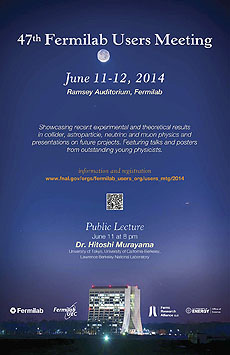 |
The 2014 Fermilab Users Meeting takes place from June 11-12. Registration is open.
|
Fermilab's 47th annual Users Meeting will take place June 11-12. The meeting is an opportunity for hundreds of scientists on Fermilab projects to discuss the laboratory's new physics results and the latest developments in collider, astroparticle, neutrino, muon and accelerator physics.
"We have come up with a balanced, two-day program that highlights the many accomplishments over the past year in the Energy, Intensity and Cosmic frontiers," said University of Nebraska's Greg Snow, Users Meeting Subcommittee chair.
The recently released P5 report will play a prominent role, with talks from P5 Chair Steve Ritz and HEPAP Chair Andy Lankford. Also on the agenda is a panel discussion that will include Nigel Lockyer and Jim Siegrist, head of the DOE Office of High Energy Physics, with ample time for questions about the P5 report. Presentations will also cover developments in the Fermilab accelerator complex, accelerator R&D and the Illinois Accelerator Research Center.
This year the Fermilab Users Organization will pay tribute to scientist Alvin Tollestrup, who has been with Fermilab since 1975. Tollestrup played a significant role in the development of the Tevatron as the world's leading high-energy physics accelerator.
"Alvin has been a very important and creative member of the particle physics community for many decades. We are indeed lucky to have him here at Fermilab, where he continues to be active," said Users Executive Committee Chair Lee Roberts of Boston University. "The tribute will be a well-deserved recognition of an exceptional career."
Every year Tollestrup presents an award, named after him, to a young, promising scientist at the laboratory. Both the URA Tollestrup Award recipient and the URA Thesis Award winner will be announced on June 11.
Two days before the Users Meeting, on June 9-10, the Fermilab Student and Postdoc Association will hold its annual New Perspectives Conference, a day and a half of talks given by undergraduate, graduate and postdoctoral students. The group will also host a poster session during the banquet on the first day of the Users Meeting.
At this year's public lecture, theoretical physicist Hitoshi Murayama will probe the age-old question of the origin of the universe in a talk titled "The Quantum Universe." Murayama holds research positions at the University of California, Berkeley and the University of Tokyo. He is also on the staff at Lawrence Berkeley National Laboratory. The talk will take place on Wednesday, June 11, at 8 p.m. in Ramsey Auditorium. Tickets are available through the Fermilab Arts and Lecture Series.
"Greg and his committee have planned an excellent and exciting program," Roberts said. "I am especially looking forward to progress reports from the wide range of experiments that the Fermilab user community is involved in."
Please register for the Users Meeting before the Wednesday, June 4 deadline. Registration is free.
—Leah Hesla
|
In memoriam: James Walton
Fermilab retiree James Walton, 70, of Sugar Grove, passed away Tuesday, May 20.
Walton began working at Fermilab in 1970. He retired in 2012 but remained active at the lab as a guest scientist.
As a high-voltage expert, Walton worked on many notable accelerator R&D projects at Fermilab.
"Jim Walton was a special person with special ways of thinking about how to solve problems. You could always ask Jim for help on oddball problems," said Fermialb scientist Helen Edwards of the Accelerator Division. "Over the years he built up a unique storage supply area in the catacombs under the transfer hall. If you had a problem and needed a different idea or something special that others would have thrown out — ask Jim."
A memorial service for Walton will be held at 7 p.m. on Wednesday, May 28, at Moss Family Funeral Homes, 209 S. Batavia Ave., in Batavia. Visitation will take place from 5 p.m. until the hour of the service. Interment will be private.
"We will miss him," Edwards said. "He was a fixture and a spirit of the old Fermilab days."
Read Walton's obituary.
|
Physicist turned 'rocket man' looks to the sky with SpaceX
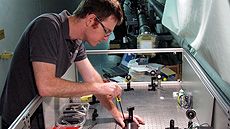 |
Sam Waldman uses skills gained through physics research to ensure safe travels for the Dragon spacecraft. Photo courtesy of Craig Hogan, PPD |
It was after 4 a.m. when Sam Waldman finally drove home from work on Easter Sunday. The particle physicist turned aerospace engineer had just witnessed via satellite feed the Dragon spacecraft dock with the International Space Station, an achievement that he helped to make possible.
"It felt pretty good," Waldman says. "By the time it is actually flying, it is a culmination of a lot of work."
Waldman works for SpaceX, a private space transport services company founded by Tesla Motors CEO Elon Musk. Waldman was responsible for building specialized sensors for the Dragon shuttle, which in 2012 earned the distinction of being the first commercial spacecraft to deliver cargo to the International Space Station and safely return cargo to Earth.
Read more
—Rhianna Wisniewski
|
Physics panel to feds: Beam us up some neutrinos
From the Associated Press, May 22, 2014
WASHINGTON (AP) — The U.S. should build a billion-dollar project to beam ghostlike subatomic particles 800 miles underground from Chicago to South Dakota, a committee of experts told the federal government Thursday.
That would help scientists learn about these puzzling particles, called neutrinos, which zip right through us.
Read more
|
LUX cools down for new run
From Sanford Underground Research Facility's Deep Thoughts, May 20, 2014
On October 30, 2013 after an 85-day run, the Large Underground Xenon (LUX) experiment announced it had the most sensitive dark matter detector in the world. No dark matter was found, but that didn't disappoint researchers.
"This is only the beginning," said Yale
physicist Dan McKinsey as he and his
co-spokesperson, Brown physicist Rick
Gaitskell, announced those first results.
"Now that we understand the instrument
and its backgrounds, we will continue
to take data, testing for more and more
elusive candidates for dark matter."
Read more
|
|
Half-life of the Higgs boson
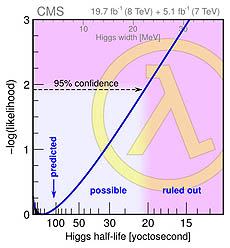 |
| This plot shows how well the Higgs half-life (λ) is known: Less than 20 yoctoseconds is ruled out with 95 percent confidence, but greater than 20 yoctoseconds is still possible. The standard prediction is that the half-life is 100 yoctoseconds.
|
It is almost two years since physicists from the CMS and ATLAS collaborations announced the discovery of a Higgs-like boson. Today, the evidence has strengthened to the point that they no longer qualify it as "Higgs-like." The signal is now much clearer, the particle is spinless (as a Higgs boson must be), more decay modes have been observed, and the proportions of decays into those modes are about right (with 15 percent uncertainties). What more could you want?
Perhaps its decay rate: The Higgs boson is an unstable particle, so it decays within a characteristic length of time. Although the time for an individual particle to decay is random, each type of particle has an average lifespan. The time for roughly half of a collection to decay is called its half-life. The half-life of the Higgs boson is not known, but it is predicted to be 100 yoctoseconds (septillionths of a second), which is a rather long time for a particle of its mass.
A measurement of the Higgs boson half-life would tell us a lot. Currently, only a few final states have been observed, which add up to about 2 percent of all predicted decays. For all we know, they might be nonstandard Higgses, and most of them might be decaying into exotic particles. Knowing the total decay rate would put an upper limit on this possibility. It would constrain even the decays that we don't see.
CMS scientists recently attempted to measure the Higgs boson's half-life and determined that it is at least 20 yoctoseconds. This analysis established a technique that will be applied to larger data sets, which are needed to fully measure it.
The technique is significant, because direct measurements of the half-life are far too insensitive. If, for instance, you tried to measure a Higgs' lifespan from the distance it flies between its production and its decay, you'd be trying to measure a distance that is much smaller than an atom, beyond the capabilities of any microscope. Instead, you might take advantage of a fact from quantum mechanics, one that states that the half-life of a particle is inversely proportional to the uncertainty in its mass. Unfortunately, the detector's mass resolution is a thousand times too insensitive to see that uncertainty. The physicists who performed this study used a clever trick involving the ratio of the real Higgs production rate divided by the virtual Higgs production rate and managed to constrain the half-life within a factor of six of its predicted value. No small feat!
—Jim Pivarski
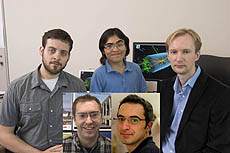 |
| These physicists contributed to this analysis. Top row, from left: Ian Anderson , Ulascan Sarica, Andrei Gritsan, all from Johns Hopkins. Bottom row, from left: Chris Martin (Johns Hopkins) and Roberto Covarelli (Rochester).
|
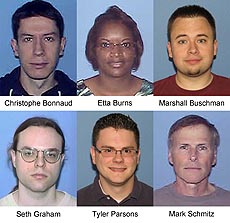 |
| Members of the Scientific Computing Division's Experiments Facilities Department provide support for Linux servers used in the CMS Remote Operations Center at Fermilab.
|
|
Li'l land lobster
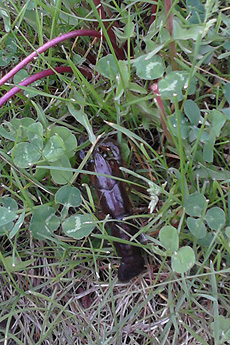 |
| A crawdad is a sign of a healthy wetland system. This guy was spotted near the Feynman Computing Center. View a one-minute video of it crawling through the grass. Photo, video: Bill Barker, CCD
|
|
Progress on electrical, mechanical systems in west remote operations center
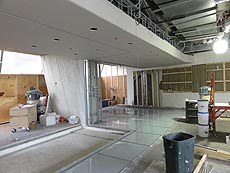 |
Floor, wall and ceiling work are under way in the new remote operations center. Photo: Steve Dixon, FESS
|
Pandecon Construction has completed the majority of the rough in work for the electrical and mechanical systems in the new remote operations center on the west side of Wilson Hall. The ceiling work, including gypsum board installation, has started and will continue in the coming weeks. Floor and wall finishes are also under way.
—Steve Dixon
|
New employees - May
The following regular employees started at Fermilab in May:
William Andrews, TD; Satoshi Hasegawa, CMS; Richard Marcum, DO; Douglas Matlock, FESS; Byron McGuire, CS; Jeffrey Spidle, CCD; Stephany Unruh, DO.
Fermilab welcomes them to the laboratory.
|
|